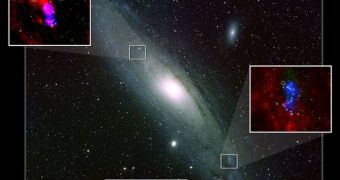An international collaboration of astronomers announces the discovery of spectral signatures thought to belong to large organic molecules inside two nearby galaxies, Andromeda and Triangulum. The molecules thought to produce these light signatures comprise of 20 atoms or more.
Though they may not seem overly complex, these molecules are a long stretch from the individual carbon monoxide molecules that permeate the Universe. They are less complex than a protein, but still rather advanced for molecules residing in open space.
Thus far, investigators only analyzed a handful of galaxies for such chemical signatures, reveals team leader Martin Cordiner, from the NASA Goddard Space Flight Center (GSFC) Center for Astrobiology.
The signature the team saw during its latest investigation are known as diffuse interstellar bands (DIB), and their nature and exact origins have remained a mystery for more than a century. Astronomers have tried to explain them, but thus far they've come up short.
Determining what DIB actually are would be just as important to astronomy as discovering dark matter. These signatures could for example help explain how stars, planets and form out of the cosmic chaos.
In spite of the fact that Andromeda and Triangulum are fairly different from the Milky Way, experts found the same types of DIB in all three galaxies. This means that the bands can permeate all sorts of environments, which could make for an interesting discovery in itself.
“We have studied DIB in incredibly diverse environments. Some have low levels of UV radiation. Some have radiation levels thousands of times higher. Some have different amounts of 'ingredients' available for making stars and planets. And throughout all of these, we see DIB,” Cordiner explains.
Speaking about the challenges associated with understanding the nature and significance of these diffuse bands, the expert said that astronomers were caught completely off-guard when the former were discovered, so long ago.
“Astronomers were used to seeing quite sharp, narrow bands where typical atoms and molecules absorb [light]. But DIB are broad; that's why they are called 'diffuse.' Some DIB have simple shapes and are quite smooth, but others have bumps and wiggles and may even be lopsided,” the investigator adds.
few telescopes worldwide are powerful enough to gather sufficient light for that, which is why most DIBs found so far have been in the Milky Way. (The team used the Gemini Observatory's telescope in Hawaii.)
If, in the end, these bands do turn out to be generated by complex molecules, then it could very well be possible that life may be possible in these two galaxies. By extension, the same may hold true for other galaxies across the Universe as well, Daily Galaxy reports.

 14 DAY TRIAL //
14 DAY TRIAL //